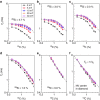Quantum decoherence dynamics of divacancy spins in silicon carbide
- PMID: 27679936
- PMCID: PMC5056425
- DOI: 10.1038/ncomms12935
Quantum decoherence dynamics of divacancy spins in silicon carbide
Abstract
Long coherence times are key to the performance of quantum bits (qubits). Here, we experimentally and theoretically show that the Hahn-echo coherence time of electron spins associated with divacancy defects in 4H-SiC reaches 1.3 ms, one of the longest Hahn-echo coherence times of an electron spin in a naturally isotopic crystal. Using a first-principles microscopic quantum-bath model, we find that two factors determine the unusually robust coherence. First, in the presence of moderate magnetic fields (30 mT and above), the 29Si and 13C paramagnetic nuclear spin baths are decoupled. In addition, because SiC is a binary crystal, homo-nuclear spin pairs are both diluted and forbidden from forming strongly coupled, nearest-neighbour spin pairs. Longer neighbour distances result in fewer nuclear spin flip-flops, a less fluctuating intra-crystalline magnetic environment, and thus a longer coherence time. Our results point to polyatomic crystals as promising hosts for coherent qubits in the solid state.
Figures





References
-
- Gruber A. et al.. Scanning confocal optical microscopy and magnetic resonance on single defect centers. Science 276, 2012–2014 (1997).
-
- Jelezko F. et al.. Observation of coherent oscillation of a single nuclear spin and realization of a two-qubit conditional quantum gate. Phys. Rev. Lett. 93, 130501 (2004). - PubMed
-
- Zwanenburg F. A. et al.. Silicon quantum electronics. Rev. Mod. Phys. 85, 961–1019 (2013).
-
- George R. E., Edwards J. P. & Ardavan A. Coherent spin control by electrical manipulation of the magnetic anisotropy. Phys. Rev. Lett. 110, 027601 (2013). - PubMed
-
- Xia K. et al.. All-optical preparation of coherent dark states of a single rare earth ion spin in a crystal. Phys. Rev. Lett. 115, 093602 (2015). - PubMed
LinkOut - more resources
Full Text Sources
Other Literature Sources

